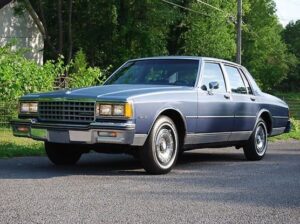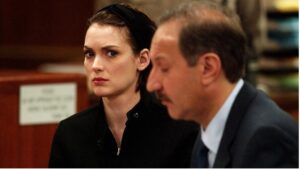The Downfall
 On a cold clear day in January 1987, Wendell Blake was picking up trash in Siever Manufacturing’s Los Angeles plant parking lot at 9:30 a.m. when he heard the grating sound of metal scraping against metal and looked up to see a tall man he recognized from company town-hall meetings, walking between cars four rows away, leaning toward the car on his right with his arm down at his side. The scraping sound stopped when the man came to the rear of the car. He walked on through the lot to a gray Mercedes, climbed in, and drove away.
On a cold clear day in January 1987, Wendell Blake was picking up trash in Siever Manufacturing’s Los Angeles plant parking lot at 9:30 a.m. when he heard the grating sound of metal scraping against metal and looked up to see a tall man he recognized from company town-hall meetings, walking between cars four rows away, leaning toward the car on his right with his arm down at his side. The scraping sound stopped when the man came to the rear of the car. He walked on through the lot to a gray Mercedes, climbed in, and drove away.
Although Blake hadn’t actually seen the man’s hand come in contact with the car, he was certain he had keyed it. A closer look at the car confirmed his conclusion. A deep scar ran along its side from headlight to taillight.
It took Blake an hour to muster the courage to report what he’d seen to security.
The following week, Siever fired James Lockhart, its Chief Operating Officer, for vandalizing an employee’s car. Lockhart denied scratching the car and sued Siever. My law firm represented the company, and I was assigned to defend the case.
Lockhart’s personnel file glowed in the dark. He received uniformly excellent performance reviews throughout his 36 years with the company, climbing the corporate ladder steadily to become its second highest-ranking executive with a half-million-dollar annual salary.

Joyce Aguilar owned the scratched car, a blue 1984 Chevrolet Caprice. It was unmarked when she parked it in the lot the morning Lockhart walked by. Five employees had reported vandalism of their cars in Siever’s lot since the fall of 1986, all scratched in the same manner as Aguilar’s Caprice. All the employees, including Aguilar, worked in low-level jobs. None of them had ever dealt directly with Lockhart.
Lockhart’s work calendar confirmed he left the building the day in question at 9:30 a.m. to attend an off-site meeting and he was present at the plant when the other five cars were keyed.
Blake had worked for Siever for six years as a Custodian in the Maintenance Department. His personnel file was unremarkable: average ratings, no commendations, no discipline. He had never interacted with Lockhart.
I could find no motive for Lockhart to vandalize Aguilar’s car or for Blake to lie about him.
Ward Dunham, the CEO, made the decision to discharge Lockhart. “Blake was afraid he’d be fired for going against Jim,” he told me. “I admired him for coming forward, and I believed him. When I met with Jim, his angry denials didn’t ring true. Underneath his defensiveness, I sensed some sort of problem. I tried to get him to open up, but that only made him angrier. If he’d admitted the vandalism, we might have been able to work something out, but he wouldn’t give an inch. I felt I had no choice but to let him go.”
 I questioned Blake in Siever’s conference room. A short stocky African American man, pushing forty, dressed in grease-smudged khaki work clothes, he answered my questions in a halting voice for an hour. I couldn’t shake his story.
I questioned Blake in Siever’s conference room. A short stocky African American man, pushing forty, dressed in grease-smudged khaki work clothes, he answered my questions in a halting voice for an hour. I couldn’t shake his story.
His answer to my last question was telling. “Why did you come forward, Mr. Blake?” I asked. “Why didn’t you lay low to stay out of trouble?”
He gave me a tired look. “The next car he scratched would be my fault much as him.”
I believed Blake.
I took Lockhart’s deposition. Sixty-two years old, six-feet-four with a mane of gray hair, dressed in a blue suit, white shirt, and yellow tie, he was a portrait of integrity. He said he’d worked long and hard to build a successful career at Siever. “The idea that I’d throw it all away to vandalize someone’s automobile is ludicrous.”
I believed Lockhart.
Something had to give. Either Blake was mistaken or Lockhart was mentally ill. It worried me that Blake hadn’t actually seen Lockhart’s hand pressing a key against the car. I had Blake take me to the parking lot and walk me through the incident. The facts and circumstances seemed conclusive. Based on what Blake saw and heard, Lockhart keyed the car.
I hired a private investigator to comb through Lockhart’s background. The first from his family to go to college, he joined Siever as an entry-level manager and excelled in every job he held as he rose to the top. He’d been happily married for 34 years and was active in church, community, and charitable organizations. If he was mentally ill, he hid it well.
Since I couldn’t convince myself Lockhart was lying even though Siever was paying me, I figured unbiased jurors might give him the benefit of the doubt. To avoid that risk, I decided to try to take the case away from the jury.
The law of wrongful discharge was evolving in California. Some courts implied a company could fire an employee only for “just cause,” an objective standard. Others held that a discharge decision was lawful if it was made in good faith. Under that standard, Lockhart’s termination might be lawful if Siever sincerely believed he keyed Aguilar’s car, whether or not he really did it.
Citing that case law, I filed a motion asking the judge to enter a judgment in Siever’s favor as a matter of law without a jury trial because there was no evidence Siever fired Lockhart for any reason other than its good faith belief he vandalized Aguilar’s car.
As I wrote the brief in support of the motion, I couldn’t answer the question that had nagged me since I took the case: Why would a powerful executive risk his career and good name to scratch the car of an employee he didn’t know?
At the hearing, while the judge grilled me about the limits of the good faith standard, I noticed him staring at Lockhart, sitting in the gallery. My nagging question troubles the judge, too, I thought. Convinced throughout oral argument that I was going down in flames, I was shocked when the judge granted my motion.
Lockhart’s lawyer was shocked, too. His Notice of Appeal hit my desk with lightning speed.

While the appeal was pending, the private investigator found an obscure misdemeanor conviction against Lockhart. In July, 1986, a Nordstrom’s store clerk caught him trying to shoplift a shirt and pair of slacks tucked under his jacket.
The similarity to the car vandalism was striking, a petty crime Lockhart had no reason to commit. That clinched it for me. As Ward Dunham had sensed, some sort of emotional problem lurked beneath Lockhart’s image of righteous probity.
It was too late to add the conviction to the record on appeal, so I put it in my pocket. If we were reversed and the case went to trial, I hoped to pull a Perry Mason and hit Lockhart with it on the witness stand.
I didn’t get the chance. The appellate court three-judge-panel ruled in Siever’s favor and Lockhart didn’t appeal the decision to the California Supreme Court. His years of service and age qualified him for a substantial pension despite his discharge, so he abandoned the case, took his retirement benefit, and moved to northern California’s wine country.
The case was closed. I’d secured the desired result, and Siever was pleased with my work. All was right with the world.
Then came the surprise that haunts me still. Over a six-week period in the spring of 1991, three months after Lockhart left Los Angeles, someone vandalized four cars in Siever’s parking lot. All were keyed in the same manner as the 1986–87 incidents with a deep scar running from headlight to taillight. One of the four cars scratched was Joyce Aguilar’s Chevy Caprice.
“I’m certain Jim vandalized the first set of cars,” Ward Dunham told me. “As far as I’m concerned, that shoplifting conviction removes all doubt. This new wave has to be the work of a copycat.”
I wasn’t so sure. Two things worried me: our case against Lockhart turned on a single eye witness; and the odds against different unrelated vandals randomly targeting Aguilar’s Chevy Caprice four years apart seemed astronomical. “It might be a good idea,” I told Dunham, “to watch Wendell Blake and Joyce Aguilar for a while.”
Siever put Aguilar and Blake under covert surveillance at work. They did nothing suspicious. Time passed. No new incidents occurred. Siever dropped its investigation, and the 1991 vandal was never identified.

Thirty-five years after I first opened the case file, I still worry that I helped destroy an innocent man’s career. Searching for reassurance as I wrote this, I found a surprising number of convictions of highly successful people for committing senseless small crimes. Most notoriously, the actress, Winona Ryder, shoplifted clothes and jewelry from Saks Fifth Avenue. Most of these people suffered from depression and repressed anger. Maybe Lockhart was such a person. If so, he betrayed no hint of it when I took his deposition in 1987, and in photos of his eighty-eighth birthday party posted on an old Facebook page, he still looked like a paragon of virtue, content and at peace with himself.
Who committed these crimes? Lockhart and a copycat? Blake? Aguilar? Or someone else? Maddeningly, I’ll never know for sure. Lockhart died peacefully at home in 2016 at the age of 91, taking the truth with him to his grave.
Post Script: To protect the privilege, I changed a few of the less important facts and the names of Lockhart, the company, and its employees.



September 6, 2021 @ 10:06 am
Wow, Ken. I can only imagine what it is like to think through all of the cases you have had over your career and wonder about the things that gave you pause. This (as always) is an excellent blog.
September 7, 2021 @ 8:03 am
Thanks, Eric! I got an email from a public defender who read the blog. He lost a double murder case when he was convinced his client was innocent. He’s been carrying that burden around for twenty years. Makes my case pale in comparison and makes me kinda glad my practice was civil law and not criminal. This was one of my strangest cases, though, from a psychological standpoint.
September 6, 2021 @ 8:00 am
Understood. Let’s get a lunch on calendar. I’m happy to come your way.
September 5, 2021 @ 12:28 pm
Ken, reminds me of my teaching days when I just couldn’t get either child to admit wrong!! Sometimes I just had to leave it to the only being that knows all !!
September 5, 2021 @ 12:38 pm
Thanks, Betty Lou. I guess that’s the best advice on this one.
September 4, 2021 @ 8:36 pm
Very Interesting story.….Thank you for sharing ..:)
September 5, 2021 @ 12:37 pm
Thanks, Janet.
September 4, 2021 @ 7:50 am
Guilt, innocence, and the vagaries of justice are topics that continue to fascinate me, Ken. Your story adds to the mystery. Another thought-provoking post. Thanks.
September 4, 2021 @ 8:08 am
Thanks, Gay. Fascinates me, too, but in this case, because of my personal involvement, it drives me a little bit nuts.
September 3, 2021 @ 7:31 pm
This sounds like a case that ought to show up on CBS’s 48 Hours. I’m voting for guilty with some kind of deep-seated mental health issues, the nature of which I couldn’t begin to fathom. Sad, though.
September 4, 2021 @ 8:07 am
I think he was guilty, too, but it’s a close call for me. Researching the other successful people convicted of senseless misdemeanors gave me a little more confidence. There is a strange sickness here.
September 3, 2021 @ 2:03 pm
A puzzlement to be sure. It brings the words, “Here-say” to my mind, the gentleman not having actually seen the keying take place. It seems like a man’s life’s work and reputation are at stake and is totally destroyed because the gentleman thought he heard a loud scratching sound. In my opinion he should not have been fired. I can see why you still think of this at times. Thanks Kenny for sharing your thoughts and stories. You always hold my attention!?
September 3, 2021 @ 4:18 pm
Thanks, Linda! This case will stick in my craw forever, I guess.
September 3, 2021 @ 11:59 am
Very interesting story, Ken.
September 3, 2021 @ 1:20 pm
Thanks, Mike! It was a fascinating case to handle.
September 3, 2021 @ 10:37 am
I have no clue who did it the second time. I’m fairly sure it was Lockhart the first time. It was a fascinating case and you handled it well, keeping it away from the jury. I wonder if Lockhart had some neurological problem going on that
kept him from being aware of what he did.
September 3, 2021 @ 1:19 pm
Thanks, Nancy! About that neurological issue, one of the judges on the appellate panel asked me during oral argument why the company didn’t consider giving Lockhart counseling for a compulsive psych disorder before it fired him. I had not anticipated that question and was caught off guard. On the spur of the moment, I answered that his vehement denials of the vandalism cut off any possibility of rehab counseling. Later, because of that question, I wondered if this kind of covert petty criminal mischief, vandalism and shoplifting, was in fact a compulsion similar to addiction. Alcoholics are often in denial. “I can set the bottle down any time I want. I just don’t want to,” they say and they truly believe it. Maybe that’s what was going on with Lockhart. He certainly seemed to believe his denials.
September 3, 2021 @ 10:36 am
Another griping story from your desk! What a bizarre set of facts. Sounds like Lockhart had a good life afterward — nothing you should feel guilty about.
September 3, 2021 @ 1:06 pm
I feel more confused than guilty, as well as a little aggravated that I’ll never know the truth for sure. As I grow older, questions from past experiences I’ll never be able to answer bother me like an itch I can’t scratch
September 3, 2021 @ 10:24 am
This is amazing . As you might recall, Faustman and a tried the case of TM v HAC which involved the vandalism of a car by an African-American employee. We lost our MSJ but won the trial. From this case came an all tine great exchange on cross.
Faustman — Isn’t it true you smashed his car with a crow bar?
TM — No. It wasn’t no crow bar.
Faustman — No? What was it?
TM — It was a tire iron.
Thorn also had a case for HAC involving HAC. Is that the one you wrote about changing the names to protect the innocent.?
September 3, 2021 @ 1:03 pm
I don’t remember your crowbar case, but TM knew what he was talking about. From my days assisting a mechanic, I learned a crowbar technically doesn’t always have the lug wrench on one end, like a tire iron. It’s just a straight or bent bar you use for prying open. We lawyers gotta know these technical details!
My case was very strange from a psychological standpoint. I never felt certain I’d figured out all the players. I don’t want to comment on it more here. I’ll tell you more next time I see you.